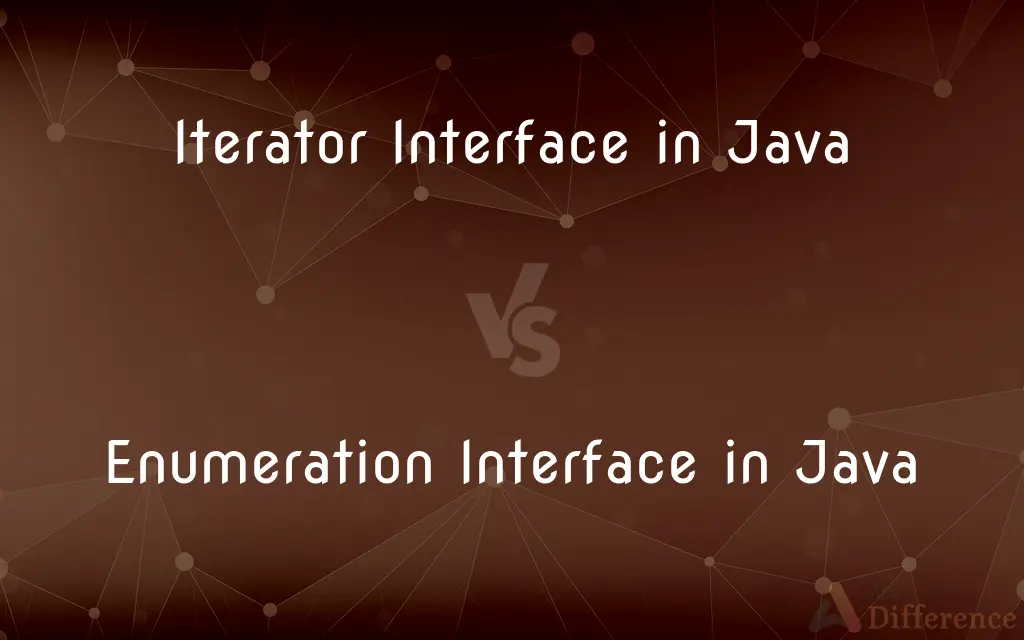Iterator Interface in Java vs. Enumeration Interface in Java — What's the Difference?
By Tayyaba Rehman & Urooj Arif — Published on January 31, 2024
Iterator in Java is an interface for iterating over a collection, offering element removal; Enumeration is older, providing only object traversal.

Difference Between Iterator Interface in Java and Enumeration Interface in Java
Table of Contents
ADVERTISEMENT
Key Differences
The Iterator Interface in Java provides a way to access elements of a collection sequentially and includes methods for checking the next element, retrieving it, and removing elements. The Enumeration Interface, an older Java interface, also allows sequential access to elements of a collection but lacks the ability to modify the collection by removing elements.
Iterator is more flexible and powerful compared to Enumeration, as it supports the remove operation, which can alter the underlying collection while iterating. In contrast, Enumeration is primarily for read-only access, offering a safer option when modification of the collection is not desired or necessary.
Java's Iterator Interface includes methods such as 'hasNext()', 'next()', and 'remove()', making it suitable for a wide range of collection operations. Enumeration Interface is limited to 'hasMoreElements()' and 'nextElement()' methods, emphasizing its role in legacy systems where collection manipulation is not required.
Iterator was introduced in Java 1.2 as part of the Collections Framework, offering a more modern approach to collection iteration. Enumeration, on the other hand, predates the Collections Framework and is retained for compatibility with older Java applications and APIs.
While both Iterator and Enumeration provide ways to traverse through elements, Iterator's capability to safely modify the collection during iteration makes it a preferred choice in modern Java programming. Enumeration is generally used in scenarios where legacy code needs to be maintained or compatibility is a concern.
ADVERTISEMENT
Comparison Chart
Modification Capability
Supports element removal
No support for element removal
Methods
HasNext(), next(), remove()
HasMoreElements(), nextElement()
Collection Manipulation
Can modify collection during iteration
Only allows traversal, no modification
Introduction
Part of Java 1.2 Collections Framework
Predates Collections Framework
Use Case
Preferred in modern Java applications
Used in legacy systems and older codebases
Compare with Definitions
Iterator Interface in Java
Facilitates sequential access to a collection's elements.
The Iterator interface made it easy to loop through the ArrayList.
Enumeration Interface in Java
Older method for sequential element access in Java.
Enumeration interface was utilized for reading data from legacy collections.
Iterator Interface in Java
Provides a standard way to traverse through collection elements.
We implemented the Iterator interface to navigate through the custom collection.
Enumeration Interface in Java
A legacy interface for traversing Java collections.
We used the Enumeration interface to access elements in the Vector.
Iterator Interface in Java
Allows modification of a collection during iteration.
Using the Iterator interface, I removed elements while iterating the list.
Enumeration Interface in Java
A simpler, non-modifiable approach to collection traversal.
For read-only access, the Enumeration interface was the preferred choice.
Iterator Interface in Java
An advanced tool for collection manipulation in Java.
Iterator interface was used for both accessing and modifying the linked list.
Enumeration Interface in Java
An interface for element-by-element access in older Java code.
We maintained legacy code using the Enumeration interface for list processing.
Iterator Interface in Java
Offers a safer way to manipulate collections during iteration.
Iterator interface ensured safe removal of elements during iteration.
Enumeration Interface in Java
Provides read-only access to collection elements.
Enumeration interface was perfect for iterating over the list without modifying it.
Common Curiosities
Can the Iterator Interface modify a collection?
Yes, it can modify a collection by removing elements.
What is the Iterator Interface in Java?
It's an interface for accessing and manipulating elements in a collection.
What is the Enumeration Interface in Java?
It's a legacy interface for traversing elements in a collection.
Why is the Enumeration Interface still used?
It's used for backward compatibility with legacy Java code.
What are the key methods of the Iterator Interface?
Key methods are 'hasNext()', 'next()', and 'remove()'.
Does the Enumeration Interface allow collection modification?
No, it only allows read-only access to elements.
What are the main methods of the Enumeration Interface?
The main methods are 'hasMoreElements()' and 'nextElement()'.
Is the Iterator Interface compatible with all Java collections?
Yes, it's compatible with all standard Java collections.
Is the Iterator Interface preferable in modern Java programming?
Yes, it's more flexible and powerful for current applications.
How does the Iterator Interface ensure safe collection modification?
By allowing element removal directly through its methods.
Can Enumeration modify elements while iterating?
No, Enumeration cannot modify the collection.
Does the Iterator Interface support concurrent modification?
It can lead to 'ConcurrentModificationException' if not handled properly.
Why was the Iterator Interface introduced in Java?
To provide a more versatile and robust way of iterating over collections.
When was the Iterator Interface introduced in Java?
It was introduced in Java 1.2 as part of the Collections Framework.
What is a common use case for the Enumeration Interface?
It's commonly used in older Java applications and APIs.
Share Your Discovery

Previous Comparison
Contiguous Memory Allocation vs. Noncontiguous Memory Allocation
Next Comparison
Wii vs. Wii UAuthor Spotlight
Written by
Tayyaba RehmanTayyaba Rehman is a distinguished writer, currently serving as a primary contributor to askdifference.com. As a researcher in semantics and etymology, Tayyaba's passion for the complexity of languages and their distinctions has found a perfect home on the platform. Tayyaba delves into the intricacies of language, distinguishing between commonly confused words and phrases, thereby providing clarity for readers worldwide.
Co-written by
Urooj ArifUrooj is a skilled content writer at Ask Difference, known for her exceptional ability to simplify complex topics into engaging and informative content. With a passion for research and a flair for clear, concise writing, she consistently delivers articles that resonate with our diverse audience.














































